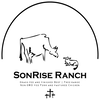So, a 12 acre lot for 50 hogs quickly becomes a 200 foot area that is a continuous, overused bathroom. To solve this problem, industrial farmers developed huge, indoor hog operations--that often require an even larger manure holding pond to contain the waste. This type of operation is where most of the commodity, commercial pork produced today comes from.
Well, what can we do about this? First, we can make that 12 acres into 24 half-acre sub-lots, and then rotate the hogs between them. This, too, has some real disadvantages, first, this requires a ton of work and materials--after all, making one 200 square foot hog pen is a huge undertaking (hogs are very hard on things); making 24 half-acre, hog secure plots would take us 3 months here at the ranch. The capital expenditure and physical output of this plan just doesn't pay. Furthermore, remember that we said hog manure is valuable; so, even if you had the energy to rearrange your half-acre plots all the time, you would still have very large amounts of hog manure in only limited areas--and over time your land would become "pig sick." Thus, you would lose the value of all that embedded phosphorus.
To solve this dilemma, we have developed a Hog Tractor. Now, here is how this thing works...it is essentially a floor-less hog pen that is heavy enough so the hogs can't move it, but light enough to be towed behind a small tractor. It has a water station (the white bucket) and a feeder, as well as plates along the sides that prevent the hog from rooting out and becoming "free range" forever!
The advantages of this are tremendous. First, we get free tilling--so you typically find our Hog Tractors in places that need a good "turning over," like our blackberry roots, or garden mulch. Free labor! Gotta love it. Secondly, we evenly distribute our phosphorus across our fields so that our land doesn't get "pig sick." Finally, our Hogs are happy! They love a good, fresh plot of ground each day to stick their snouts into...and that is what makes for fresh, clean tasting free range pork.

 RSS Feed
RSS Feed